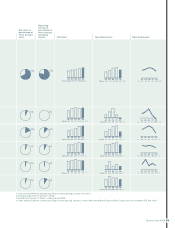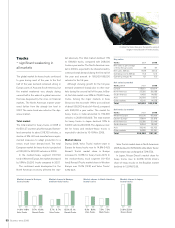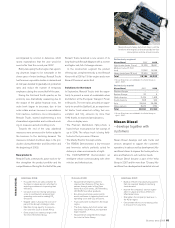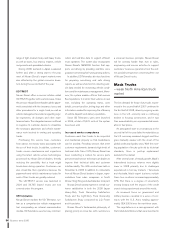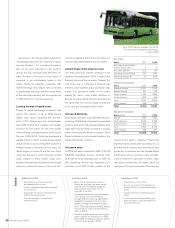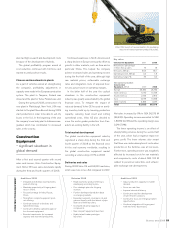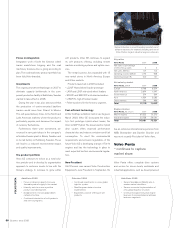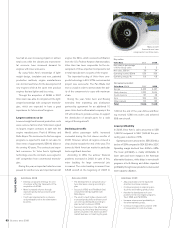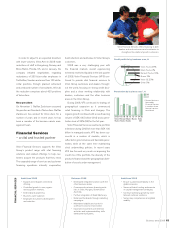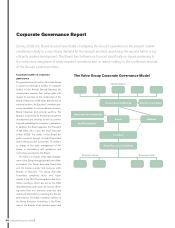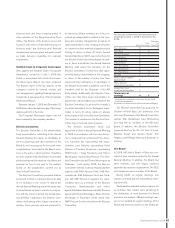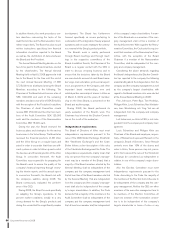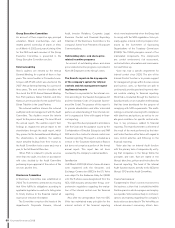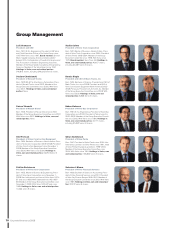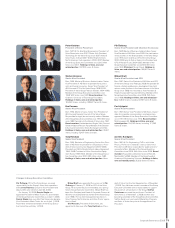Volvo 2008 Annual Report Download - page 65
Download and view the complete annual report
Please find page 65 of the 2008 Volvo annual report below. You can navigate through the pages in the report by either clicking on the pages listed below, or by using the keyword search tool below to find specific information within the annual report.
gensets and container handling equipment.
Volvo Penta contributes with substantial
synergies and economies of scale to the Volvo
Group’s total production of diesel engines.
During 2008, Volvo Penta sold approximately
30,000 marine and industrial engines based
on the Group’s diesel engine platforms. The
majority of these volumes consist of industrial
engines – a business that Volvo Penta has
expanded considerably in recent years. With
unique performance characteristics and low
emissions Volvo Penta’s drive systems contrib-
ute to strengthening the competitiveness of
industrial engine customers such as Kalmar
Industries, Sandvik and Atlas Copco.
This type of customer, with operations
worldwide, can have global support for its
operation through the Volvo Group’s complete
product and service offering.
On the marine engine side, Volvo Penta
delivers engines and drive systems to world-
leading boat builders suchas Fairline, Sun-
seeker, Riviera, Four Winns, Jeanneau/Bene-
teau and Cranchi. With innovative technological
solutions and integrated drive systems, Volvo
Penta creates considerable advantages for
the customer in the form lower fuel consump-
tion and shorter installation times.
During the year, Volvo Penta continued the
launch of Volvo Penta IPS – the acclaimed
drive system with forward-facing propellers
and steerable drive units. With new and larger
drive units connected to the Volvo Group’s
11-liter engine, Volvo Penta has expanded its
IPS offering with two new power classes:
IPS800 and IPS900. With multi installations
of these systems, Volvo Penta can offer drive
systems for boats up to 100 feet.
For sailboats, Volvo Penta during the year
launched a new series of diesel engines with
very low emission and noise levels. Standard
engines from the same engine family are
installed in all of the yachts taking part in the
Volvo Ocean Race.
Total market
The total market for marine engines weakened
in Europa, while demand for industrial engines
continued to be relatively stable.
In North America, the weakening trend of
recent years in the marine engine market con-
tinued. Following the fi nancial crisis during the
second half of the year, boat sales in North
America declined to historically low levels.
In Asia and many markets in other parts of
the world, for instance the Middle East and
South America, demand for industrial engines
and marine engines continued to be favorable.
Market share development
With aggressive investments in product devel-
opment and product renewal, Volvo Penta has
created a modern and complete product port-
folio that is in demand from a growing number
of boat builders and industrial engine custom-
ers around the world.
Volvo Penta has consolidated and strength-
ened its market share in most market seg-
ments, not least thanks to continued great
success for Volvo Penta IPS, which to an ever
greater extent replaces traditional shaft instal-
lations in the inboard segment.
Financial performance
In total, net sales amounted to SEK 11,433 M,
compared to SEK 11,719 M in the preceding
year. Operating income amounted to SEK 928
M compared to SEK 1,173 M the preceding
year. Operating margin amounted to 8.1% (10.0).
Operating income was negatively impacted
by sharply lower volumes during the second
half of the year, increased under-absorption of
costs in production and one-time costs of
about SEK 100 M associated with carried-out
adjustments of operations to lower demand.
Production and investments
During the year, Volvo Penta invested approxi-
mately SEK 100 M in a new logistics system
that fully implemented will enable substantial
effi ciency improvements in the entire chain
from order to delivery.
Production in the plants in Vara, Sweden
and Lexington, Tennessee, USA was gradually
lowered in line with falling demand for marine
engines. Towards the end of the year, Volvo
Penta was forced to implement personnel
reductions in both factories and central admin-
istration to adjust the company to a signifi -
cantly lower demand as a consequence of a
weaker world market.
Volvo Aero
– leader in lightweight designs
Volvo Aero has for a long time played an import-
ant part as a manufacturing partner in the air-
craft engine industry. This role has in recent
years changed as Volvo Aero has asssumed
greater responsibility as a partner in the devel-
opment of new engine programs.
Today, Volvo Aero develops its own unique
technologies which are important to partners
and other customers in the aerospace indus-
try. The technology development is mainly
concentrated on lightweight designs.
Highly-interesting technologies
Lightweight design has a tremendous import-
ance for engines’ fuel consumption and thus
for emissions. This makes Volvo Aero’s tech-
nologies highly interesting, since the oil price
Business areas 2008
61


